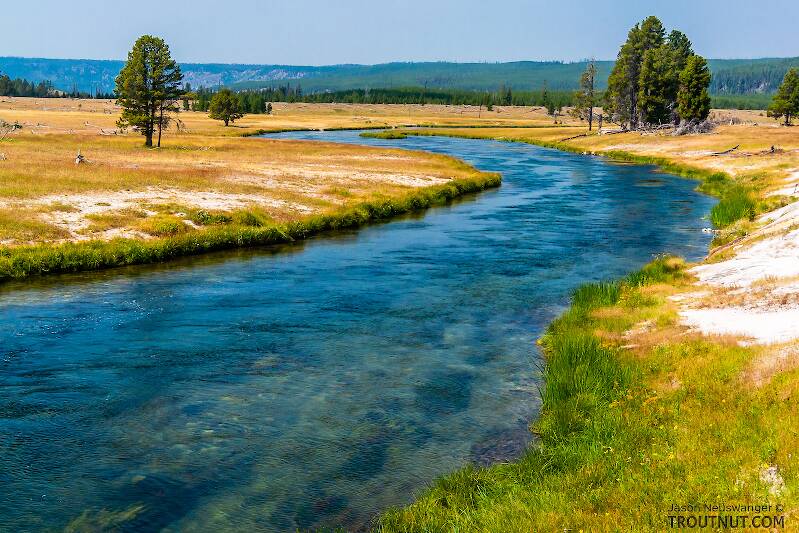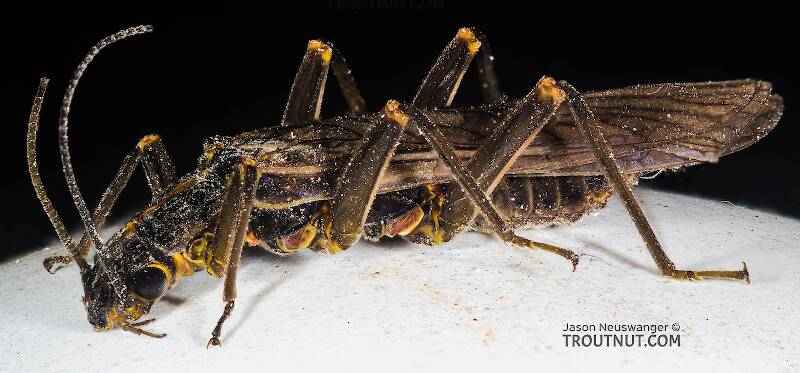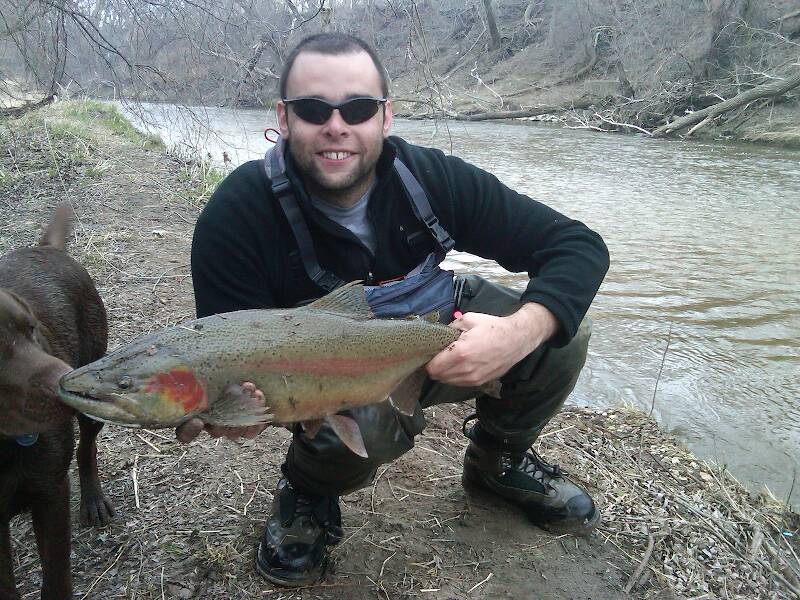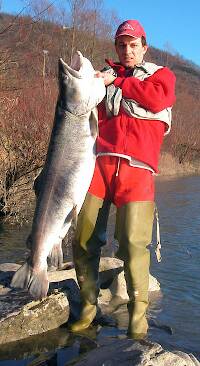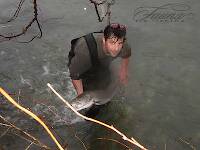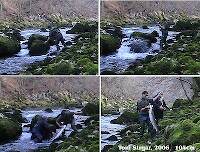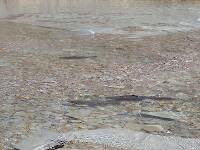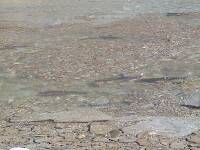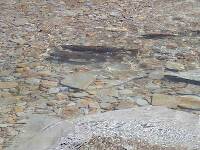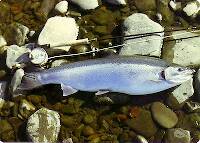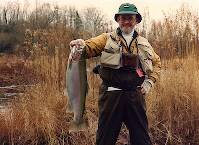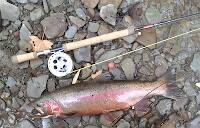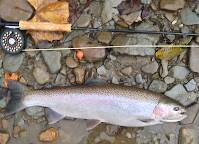
Salmonflies
Pteronarcys californica
The giant Salmonflies of the Western mountains are legendary for their proclivity to elicit consistent dry-fly action and ferocious strikes.
Featured on the forum

Troutnut is a project started in 2003 by salmonid ecologist Jason "Troutnut" Neuswanger to help anglers and
fly tyers unabashedly embrace the entomological side of the sport. Learn more about Troutnut or
support the project for an enhanced experience here.
Jmd123 on May 2, 2013May 2nd, 2013, 6:52 pm EDT
Okay, here's a topic for you all. I have been fishing on my local small stream, the Pine River, twice now and have come up pretty much bust - 6 1/2 hours of fishing since the opener last Saturday, and all of three hits and one 3" rainbow to show for it. So alright, we had a long cold awful winter, and the bugs just haven't showed up yet. Nevertheless, as I'm sure most of you have experienced, you can usually "pound up" a few fish with a searching dry pattern, such as an elkhair caddis (which I have been using), or get a few to pop at a streamer or Woolly Bugger. At least something!
Well, this is a stream about 10-20 feet wide, and ankle- to knee-deep for most of it except for the deeper holes. And, there are currently steelhead spawning in there, as evidenced by freshly-churned gravel beds and a good 18-20" dark fish I spooked out of a shallow slot next to said gravel beds yesterday.
So, here's the question: do migratory fish of 3-4 times the size of the average stream resident fish spook the residents? Keep them scared enough to hole up and not come out to pop a few insects off the top? I mean I didn't even spook any smaller fish, typically that happens, but the only one I saw was the (likely) steelie, far bigger than anything I've caught yet out of there.
So folks, any thoughts on this? Mack, you're a small stream kind of guy, what do you think?
Jonathon
P.S. I heard a green frog on the river yesterday and can hear tree frogs outside my window right now. How about some freakin' bugs already??? I am DYING for a hatch!
Well, this is a stream about 10-20 feet wide, and ankle- to knee-deep for most of it except for the deeper holes. And, there are currently steelhead spawning in there, as evidenced by freshly-churned gravel beds and a good 18-20" dark fish I spooked out of a shallow slot next to said gravel beds yesterday.
So, here's the question: do migratory fish of 3-4 times the size of the average stream resident fish spook the residents? Keep them scared enough to hole up and not come out to pop a few insects off the top? I mean I didn't even spook any smaller fish, typically that happens, but the only one I saw was the (likely) steelie, far bigger than anything I've caught yet out of there.
So folks, any thoughts on this? Mack, you're a small stream kind of guy, what do you think?
Jonathon
P.S. I heard a green frog on the river yesterday and can hear tree frogs outside my window right now. How about some freakin' bugs already??? I am DYING for a hatch!
No matter how big the one you just caught is, there's always a bigger one out there somewhere...
Sayfu
Posts: 560
Posts: 560
Sayfu on May 3, 2013May 3rd, 2013, 5:20 am EDT
Steelhead will scare the bejesus out of cutthroat trout, and drive them to spawn in small tribs far up in the trib to get away from browns,and rainbows as well. Cutthroats can not take pressure from other trout regarding their spawning. Rainbows? Doesn't seem to bother them all that much, and they will drop back, and feed on the steelhead spawn. But no hatch going on, and cold water at this time of year? I can't expect to get fish up on searching patterns. On my rainbow dominant Yakima River, the Native Americans established a King Salmon Hatchery at the head of the system. Trout anglers thought that was the end of the rainbow fishing. Rainbows grew to incredible size feeding on the salmon smolt after the plant. It created some great, streamer fishing. Alaska has many examples to demonstrate that point. Steelhead would run rainbows off the redds, but the rainbows just drop back, and feed on the eggs.
Kschaefer3 on May 3, 2013May 3rd, 2013, 5:25 am EDT
If you are fishing for browns I would doubt it bothers them. I just think it is way too cold and your resident trout have serious lock jaw. I know of a couple streams you can go catch a nice resident brown on one cast and a steelhead on the next.
PaulRoberts on May 3, 2013May 3rd, 2013, 6:39 am EDT
No. Shouldn't bother them. The steelhead will defend some space around the redd but the residents will find feeding space. And as Sayfu said, trout will eat the eggs. Egg patterns will be recognized as "food".
As to the catching, something else is going on.
As to the catching, something else is going on.
Jmd123 on May 3, 2013May 3rd, 2013, 9:32 am EDT
So I guess I should be throwing egg patterns? Hey, I might get a steelie on my 3-weight! That would sure make for some excitement...
Jonathon
Jonathon
No matter how big the one you just caught is, there's always a bigger one out there somewhere...
Entoman on May 4, 2013May 4th, 2013, 2:30 pm EDT
Jonathon,
So if the fish won't rise to your fly, it's because they may have been chased away by steelhead?:) Unless something terrible happened to the populations that provided the great fishing you experienced last Summer, the fish are still there, just not engaging in the behavior you'd prefer. Trying to "pound them up" in the circumstances of a late Spring is a commonly practiced but low percentage proposition. Dry fly purists of the old school did just that and enjoyed many a fine (but fishless) Spring day... Or you could fish nymphs, which would be my advice.
That's not an uncommon complaint. All I can say is learn to fish them so that they don't do it so much. There's no getting around the learning curve involved with the three dimensional presentation required. Proper depth, drift control and strike detection take time and effort. So does learning the proper selection of tackle/flies to match the circumstances. But it's worth the challenge as it will open up the whole range of possibilities for you between casting Comets and Elk Hairs. Try one off the back of your Elk Hair in the shallows or high sticking in some of the deeper slots or around structure. I think you may be surprised at the results, especially with the latter for those steelhead.:)
So if the fish won't rise to your fly, it's because they may have been chased away by steelhead?:) Unless something terrible happened to the populations that provided the great fishing you experienced last Summer, the fish are still there, just not engaging in the behavior you'd prefer. Trying to "pound them up" in the circumstances of a late Spring is a commonly practiced but low percentage proposition. Dry fly purists of the old school did just that and enjoyed many a fine (but fishless) Spring day... Or you could fish nymphs, which would be my advice.
My nymphs just all seems to hang up on the bottom, so I don't...nymph, that is...
That's not an uncommon complaint. All I can say is learn to fish them so that they don't do it so much. There's no getting around the learning curve involved with the three dimensional presentation required. Proper depth, drift control and strike detection take time and effort. So does learning the proper selection of tackle/flies to match the circumstances. But it's worth the challenge as it will open up the whole range of possibilities for you between casting Comets and Elk Hairs. Try one off the back of your Elk Hair in the shallows or high sticking in some of the deeper slots or around structure. I think you may be surprised at the results, especially with the latter for those steelhead.:)
"It's not that I find fishing so important, it's just that I find all other endeavors of Man equally unimportant... And not nearly as much fun!" Robert Traver, Anatomy of a Fisherman
Oldredbarn on May 5, 2013May 5th, 2013, 8:40 am EDT
So if the fish won't rise to your fly, it's because they may have been chased away by steelhead?:)
What's wrong with this picture, ladies and gentlemen of the angle..."I'm upset because these big bully steelhead are scarring away my dinks???" Say what?! :) I say, stop screwing around and put a hook in one of those bad boy's lip!
On topic...Jonathon asked me this question in a PM and I've been just a bit too busy to respond...In between fishing trips, my wife has reminded me, "there is a lawn out there mister!"...So, tying, fertilize, watch the Wings, plant some lilies, plan the next fishing trip, mow the lawn, turn on the sprikler system, fix sprinkler sysyem, etc, etc! :)
There was an interesting article writen about this that I have stowed away somewhere in the closet with 2 million other old magazines...It was done by a fish biologist about a study he had done on the Pere Marquette here in Michigan.
The article could be 20 years old.
For those not familiar with the PM, as we call it, it is one of the few rivers we have here that is not obstructed with dams...Fish can swimn from Lake Michigan to nearly the center of the state to the town of Baldwin and even further up into the smaller feeder creeks that drain that side of the state. It is a wonderful river.
If my memory serves me right, the PM was the first river in Michigan to receive Brown trout from Germany, via the Northville Michigan hatchery a few blocks from where I sit as I write this.
In the mid-60's, give or take, the powers that be decided to plant steelhead here in Michigan...and then salmon. It is a rather long story, but part of the propaganda to pull it off had to do with very large white fish die-offs that happened every year stinking up the beautiful, tourist beckoning, beaches of Lake Michigan.
The steelhead were planted in the PM, but from what I understand, the King salmon run there was not man-made...The salmon found their own way in to the stream and now each fall the run is quite spectacular.
An aside: In the late 50's, early 60's I still lived in Norfolk VA...Basically living life as a Navy brat and fishing the back bays of the Chesapeake Bay, with my dad...He was originally from Michigan and we would come home to visit once in awhile...He had an uncle who ran a very large orchard near Bear Lake (don't ask me about Bear Creek and the large bullying trout there...I know nothing! ;)
Anyway...my great uncle would take us out to the break walls on Lake Michigan in Manistee, or Frankfort. We caught buckets of large perch. This was pre the introduction of the big fish.
Ok...About the study. The guy found that with the salmon and steelhead running up and down the PM that it was causing issues with the Brown Trout population there...There is only so much room and spawning gravel and the competition was causing a decline in the Browns.
He actually mentioned, in the article, my "secret" fishing river near my grandmother's place that I fished as a kid, the Middle Branch of the Muskegon. He stated that my little creek had more Brown's in it of size than the famous PM (forget you ever heard this) and he blamed the anadromous fish stressing the local Browns on the PM...There are no steelies etc in the little creek. (There are some very beautiful, wild, wary, brookies in there as well...Those large Browns can keep them Brookies honest. ;) Forget that too!)
Not sure if the biologist would say that they "scared" the locals, but that the competition was a problem.
There's my two-cents...:)
Spence
"Even when my best efforts fail it's a satisfying challenge, and that, after all, is the essence of fly fishing." -Chauncy Lively
"Envy not the man who lives beside the river, but the man the river flows through." Joseph T Heywood
"Envy not the man who lives beside the river, but the man the river flows through." Joseph T Heywood
Sayfu
Posts: 560
Posts: 560
Sayfu on May 5, 2013May 5th, 2013, 3:00 pm EDT
That gets to the size of the anadromous runs, and the size of the rivers they run in. In the Olympic Penninsula Rivers where salmon run as well as steelhead, there are very few native populations of trout. The trout fishing is for sea-run cutthroat that enter, and spawn far up the headwater areas void of Salmon and Steelhead. Just another thought.
Oldredbarn on May 5, 2013May 5th, 2013, 8:33 pm EDT
Josh,
You bring up a very good point. In a stream where the runs have been going on from the beginning of time with the river basically to themselves things have had time to evolve or adjust...The Pere Marquette is technically a man-made situation starting with non-native Browns in the late 1800's and then the addition of steelies in the mid-60's, and the salmon then finding their way up the stream, another non-native fish.
The whole thing is an artificial situation. It is odd then, considering this, that we worry about the Brown trout population or brook trout fears.
In the Au Sable, which drains on the eastern side of the state, into lake Huron things are similar. They say that the native eastern brook trout wasn't even in the river at the time that the early explorers reached there. The grayling was the fish of that stream. Some have speculated that the brooks would have eventually made it there, but we beat them.
So, even the brook trout is a non-native species in the Au Sable.
The last of the grayling disappeared in the early 1900's and I unfortunately have been heard to "joke", that the only grayling in Grayling is hanging in the Grayling restaurant.
There was a conservation officier named Rube Babbitt who introduced the brooks to the Au Sable...
Well...not to go into all this, I think we have stumbled onto a rather odd problem...There can really be no comparison between your river and the labratory of Michigan streams. Does it really matter if the brooks have night tremors when these other fish are about? The variables have been so screwed up that we wouldn't know where to start.
I really don't know what to say about the history of our streams...the great experiment of the Great Lakes Basin. I guess it is just what it is now and that's that...I have a great deal of problems with the whole "manage the resource" crowd, and those managers who's hubris makes them think that they have a better plan than the one nature has given us, when they really couldn't "manage" their way out of a wet paper bag.
Your western streams have seen their share of problems too, but here we really take the cake.
Now...I will admit that I love to fish, that I love brookies, and am very fond of Von Behr (Salmo trutta), but there does seem, at times, an artifical quality to it all...The whole damn thing seems like a big put-n-take ponzie scheme, even when I fantasize that I'm fishing over "wild" trout in the upper Au Sable because they haven't stocked there in decades...
Oh well...Sorry for the late night ramble, and I wish I had a better response to your thoughtful posts, but...There it is.
Spence
You bring up a very good point. In a stream where the runs have been going on from the beginning of time with the river basically to themselves things have had time to evolve or adjust...The Pere Marquette is technically a man-made situation starting with non-native Browns in the late 1800's and then the addition of steelies in the mid-60's, and the salmon then finding their way up the stream, another non-native fish.
The whole thing is an artificial situation. It is odd then, considering this, that we worry about the Brown trout population or brook trout fears.
In the Au Sable, which drains on the eastern side of the state, into lake Huron things are similar. They say that the native eastern brook trout wasn't even in the river at the time that the early explorers reached there. The grayling was the fish of that stream. Some have speculated that the brooks would have eventually made it there, but we beat them.
So, even the brook trout is a non-native species in the Au Sable.
The last of the grayling disappeared in the early 1900's and I unfortunately have been heard to "joke", that the only grayling in Grayling is hanging in the Grayling restaurant.
There was a conservation officier named Rube Babbitt who introduced the brooks to the Au Sable...
Well...not to go into all this, I think we have stumbled onto a rather odd problem...There can really be no comparison between your river and the labratory of Michigan streams. Does it really matter if the brooks have night tremors when these other fish are about? The variables have been so screwed up that we wouldn't know where to start.
I really don't know what to say about the history of our streams...the great experiment of the Great Lakes Basin. I guess it is just what it is now and that's that...I have a great deal of problems with the whole "manage the resource" crowd, and those managers who's hubris makes them think that they have a better plan than the one nature has given us, when they really couldn't "manage" their way out of a wet paper bag.
Your western streams have seen their share of problems too, but here we really take the cake.
Now...I will admit that I love to fish, that I love brookies, and am very fond of Von Behr (Salmo trutta), but there does seem, at times, an artifical quality to it all...The whole damn thing seems like a big put-n-take ponzie scheme, even when I fantasize that I'm fishing over "wild" trout in the upper Au Sable because they haven't stocked there in decades...
Oh well...Sorry for the late night ramble, and I wish I had a better response to your thoughtful posts, but...There it is.
Spence
"Even when my best efforts fail it's a satisfying challenge, and that, after all, is the essence of fly fishing." -Chauncy Lively
"Envy not the man who lives beside the river, but the man the river flows through." Joseph T Heywood
"Envy not the man who lives beside the river, but the man the river flows through." Joseph T Heywood
Jmd123 on May 6, 2013May 6th, 2013, 3:30 pm EDT
As I said in my other post, Spence, I tried streamers in some nice deep holes and got no response from steelhead either.
Jonathon
Jonathon
No matter how big the one you just caught is, there's always a bigger one out there somewhere...
PaulRoberts on May 6, 2013May 6th, 2013, 7:43 pm EDT
Jonathan, did you fish the streamers from upstream, swinging and/or hanging them in the pools? Spawning fish can be tough to interest, but right after they are ravenous. As they drop back to the lake they'll hold in large pools on the way. I call it "drop-back" fishing and just hit every large pool I can find. A quick hang or swing of a good sized streamer will usually catch them.
Entoman on May 6, 2013May 6th, 2013, 8:51 pm EDT
Good point, Paul. I've found the same thing in some feeder creeks to a few of my favorite lakes. The fish are pretty spooky, so I'd fish them from upstream and just feed the fly down and let it come taught in the current to just hang there awhile with the occasional twitch. It's amazing how long some of them must look at the fly before deciding to rush it.:)
Jon - There's also a large range of options between catsting streamers to them or floating dry flies over there heads. If you are going after both steelhead and trout in small water, I'd go with nymphs as your best option in the conditions you describe. Perhaps a high sticked #12 Zug Bug with a small black nymph trailing behind? You could also swing a nymph like the Prince with good results. But I've already suggested this... Sorry for repeating myself.
Jon - There's also a large range of options between catsting streamers to them or floating dry flies over there heads. If you are going after both steelhead and trout in small water, I'd go with nymphs as your best option in the conditions you describe. Perhaps a high sticked #12 Zug Bug with a small black nymph trailing behind? You could also swing a nymph like the Prince with good results. But I've already suggested this... Sorry for repeating myself.
"It's not that I find fishing so important, it's just that I find all other endeavors of Man equally unimportant... And not nearly as much fun!" Robert Traver, Anatomy of a Fisherman
Sayfu
Posts: 560
Posts: 560
Sayfu on May 7, 2013May 7th, 2013, 5:22 am EDT
I had steelheading way too good. I always wanted to target pre-spawn steelhead. Once they spawn, they drift back downstream, and are termed kelts, (downstreamers), and are thin, males dull in color, black on their bellies many of them, and are ravenous to eat. Most caught are females, for some reason. Many of the males die in their return to the sea is my assumption having spent more energy in spawning. The females do not color up that much, and anglers that keep them think they are in decent condition, but they are skinny, dull in color, and when cleaned can even have new egg skeins forming. I could often tell by the fight I had hooked a kelt. They come to net very quickly.
PaulRoberts on May 7, 2013May 7th, 2013, 7:40 am EDT
Agree with much of what Sayfu says. And yes we caught mostly females. Interesting. Recent kelts are indeed easy to catch and poor fighters. In some waters they should just be left alone. On some of our longer streams though, it takes a while for the fish to drop back. And they seem to re-energize some and can be spectacular fighters in the warming water. I've had more than one big kelt leap eye to eye with me on some of those streams.
Sayfu
Posts: 560
Posts: 560
Sayfu on May 7, 2013May 7th, 2013, 9:17 am EDT
PAUL...I didn't want to wrote a book on kelts, but your observation has been the same as mine. They will re-energize themselves, especially the females,and tend to jump a lot, and not so much run line off your reel. Their eating quality is very poor, however, the fat content of their bodies greatly depleted in spawning. I fished for steelhead so much I could recognize the deep, slow holes that they would reside in for a time in their return back to sea. Many an angler would keep these female kelts that had freshened up saying they were early, Summer-run arrivals with but small skeins forming when cleaned. But you could tell by the skinny shape of their bodies they were not early summer-runs. In some of our Western Rivers there were early Summer-run steelhead they called "Springers", and their condition, and fight was incredible. And my position on these hatchery run fish is to make your own decision on keep, or release. The game folks planted them to be kept.
Jmd123 on May 7, 2013May 7th, 2013, 5:17 pm EDT
Paul, I swung my streamers both from upstream down and across and down (casting to the opposite bank), and tried several different patterns, including my KBF, a Royal Coachman streamer (quill wing), some dark Woolly Bugger variants, and some Grizzly King variants (one with a green body and another with a yellow body). No response on anything. Gonna try again in a day or two, should be a few flies coming off now I hope! My folks are visiting so my fishing time is a bit limited.
Jonathon
Jonathon
No matter how big the one you just caught is, there's always a bigger one out there somewhere...
PaulRoberts on May 8, 2013May 8th, 2013, 7:30 am EDT
I wouldn't worry much about fly pattern. I'd use the biggest bulkiest wake-pulling-est (new word!) one you have and spend your energy hoofing. The fish you are targeting should be aggressive so no need to finagle. If they are still in the spawn or recently recuperating you may have to finagle a bit, meaning not expecting the fish to move as far for the fly. A wet fly fished deep and slowly across current can draw strikes. Here, I'd pay a little bit more to pattern (only a little) matching it to the visibility conditions. Good luck hunting.
Quick Reply
Related Discussions
Topic
Replies
Last Reply
Five days of warmwater flyfishing in southeastern Michigan - from Jonathon
In Fishing Reports by Jmd123
In Fishing Reports by Jmd123
0
Jul 22, 2009
by Jmd123
by Jmd123

